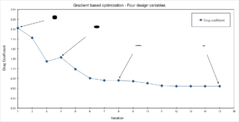Difference between revisions of "Sig Numerical Optimization / Tutorials"
From OpenFOAMWiki
(→Bounded-constrained gradient optimization study of a blunt body) |
(→Bounded-constrained gradient optimization of a blunt body) |
||
| Line 3: | Line 3: | ||
==== Bounded-constrained gradient optimization of a blunt body ==== | ==== Bounded-constrained gradient optimization of a blunt body ==== | ||
| − | [[File:blunt_body.png|thumbnail|300x122px|Blunt body with control points.]] | + | [[File:blunt_body.png|thumbnail|300x122px|Blunt body with control points. Initial shape.]] |
[[File:bbopt.png|thumbnail|300x122px|Shape optimization of the blunt body]] | [[File:bbopt.png|thumbnail|300x122px|Shape optimization of the blunt body]] | ||
Revision as of 01:24, 20 July 2014
1 Tutorials using DAKOTA
1.1 Bounded-constrained gradient optimization of a blunt body
- In this short tutorial we do a bounded-constrained gradient optimization study of a blunt body.
- We aim at optimizing the shape of a blunt body. The goal is to minimize the drag coefficient.
- The body is parametrized using Bezier curves with four control points and six linear constraints.
- To do the optimization we use Dakota, Salome and OpenFOAM. The geometry and mesh are generated with Salome.
- This tutorial works fine with OpenFOAM 2.3.0, Salome 7.3.0 and Dakota 5.4.0.
- Before running the tutorial, execute the script dakota_cleanup.
--Joegi (talk) 02:12, 20 July 2014 (CEST)

